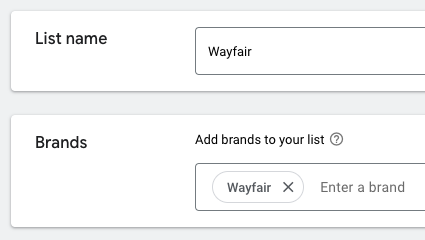Google Ads announced new Search and Performance Max settings that will help with brand safety and clearer reporting. Currently, bidding on brand keywords in a brand-specific campaign may solicit non-brand queries if Google deems the ad relevant to the user.
Two new settings — brand restrictions and brand exclusions — will ensure traffic and reporting are funneled to the right campaigns.
Brand Restrictions
Brand restrictions are available for Search campaigns where the advertiser wants an ad to show only if the brand or sub-brand is in the query. For example, Wayfair could add a brand restriction for its name so only queries with “Wayfair” or a sub-brand such as “Zipcode Design” would show ads. The restriction would negate non-brand queries.
This feature resides in the individual campaign’s settings under the “Brand restrictions” option. Advertisers can create up to 10 brand lists, adding a brand by submitting its URL. Google requires an approval form if it doesn’t recognize the brand.

Advertisers such as Wayfair can create up to 10 brand lists, adding a brand by submitting its URL.
There is a catch to using this feature, however. When advertisers turn on brand restrictions, Google automatically applies broad match keywords. Google’s rationale is presumably that broad match and smart bidding work better together. I’ve generally seen positive results with broad-match keywords, but I’m hesitant to make a complete switch.
Regardless, advertisers can test brand restrictions in two ways. The first is a 50/50 split via a custom experiment to contrast the performance of an existing campaign against a test version running brand restrictions and broad match keywords.
The second option is adding a brand restriction to an existing campaign. This would impact all traffic, but we wouldn’t expect as many irrelevant queries since it’s a brand campaign.
Brand Exclusions
Performance Max campaigns include brand and non-brand queries. Advertisers can’t separate them as with Search. The resulting revenue metrics often appear high since they include searches for brand names. The numbers are accurate, but there’s no way to isolate non-brand performance.
That’s the purpose of the new brand exclusions feature. Through the same process as restrictions, advertisers can add brands as exclusions. For example, Wayfair can exclude its brands in a Performance Max campaign if it doesn’t want those names to show an ad. Wayfair could also exclude other brands, such as Kenmore, for the same reasons.
An alternative to brand exclusions is campaign or account-level negative keywords, although the latter likely wouldn’t restrict as much traffic.
I’m not planning on adding brand exclusions right away. Including brands in Performance Max traffic can help lesser-known names. Moreover, Performance Max may have inventory that other brand campaigns don’t.




